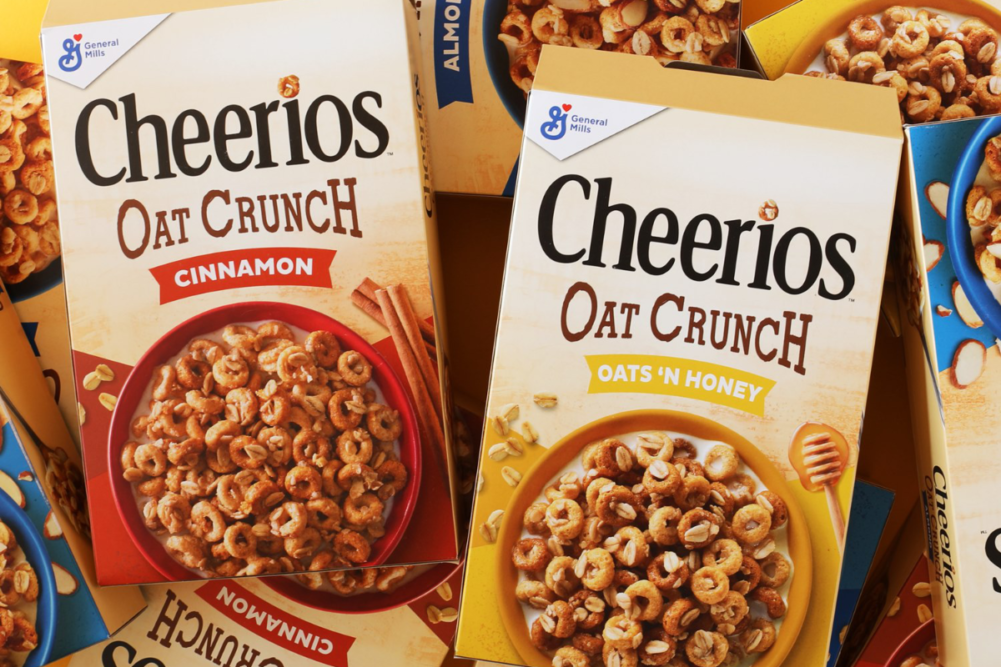MINNEAPOLIS — Amid an operating environment as tough as any experienced during his career, Jeffrey L. Harmening, chairman and chief executive officer of General Mills, Inc., said the company has enjoyed standout success in numerous categories, many in grain-based foods.
Mr. Harmening and his colleagues offered an upbeat view and said General Mills would still reach its financial goals for the year despite a tough second quarter.
In the period ended Nov. 28, General Mills net income was $597.2 million, equal to 98¢ per share on the common stock, down 13% from $688.4 million, or $1.12 per share, in the first quarter last year. Net sales were $5.024 billion, up 6%.
“We continued to compete effectively and execute well this quarter in a challenging operating environment,” Mr. Harmening said. “In the face of an unprecedented combination of input cost inflation and supply chain disruptions, we’re moving quickly to keep our trusted brands on store shelves for consumers while driving net price realization to protect our bottom line. As a result, we now expect to meet or exceed each of our financial targets for the year.
Based on the sales growth, General Mills adjusted its guidance. The company forecast organic net sales growth of 4% to 5% for the year, versus previous guidance of down 1% to 3%. The company’s earnings per share forecast for the full year currently is down 2% to up 1%, versus down 2% to flat previously.
Investors were disappointed by the quarterly results. The company’s shares dipped as low as $63.97 in New York Stock Exchange trading the morning of Dec. 21, down 6% from the $67.79 close a day earlier.
In prepared remarks for investment analysts, Mr. Harmening identified numerous difficulties the company has encountered.
“The current operating environment is as dynamic and challenging as I’ve seen in my 27-plus years in the industry,” he said. “At home food demand remained elevated, input cost inflation is at a 10-year high, and labor shortages and other issues are causing disruptions across our supply chain, from our suppliers to manufacturing to distribution. These disruptions are driving down service levels and driving up costs above and beyond inflation throughout the industry.”
Shortages and tight labor markets “are impacting every part of the supply chain, adding significant costs that are above and beyond inflation,” Mr. Harmening said. For example, the inability to secure adequate supplies of a single key ingredient in some cases will necessitate the shutdown of a production line, he said.
“If our carrier can’t make the scheduled pickup because of a driver shortage, we run the risk of missing our customers’ on-time and in-full delivery window, thus leading to fines and fees,” Mr. Harmening added.
Operating profit of the North American Retail segment of General Mills was $649 million, down 7% from the second quarter of fiscal 2021. Sales were $2.98 billion, down 2%. The sales gain was driven by higher prices and a more favorable product mix, offset by lower pound volume.
Supply chain issues pressured margins, said Kofi Bruce, chief financial officer.
“While significant benefits from positive price/mix and HMM (holistic margin management) cost savings were sufficient to offset high single-digit input cost inflation in the quarter, the large step up in cost due to supply chain disruptions, combined with volume deleverage, drove adjusted gross margin down by three points,” he said. “Adjusted operating profit margin in the quarter was down 200 basis points, driven by lower adjusted gross margin, partially offset by lower SG&A (sales, general and administrative) expenses.”
Highlighting the company’s sales success in the marketplace, Jonathon Nudi, group president, North American Retail, offered numerous examples, several in grain-based foods categories. He detailed what he termed a “multi-year success story in US cereal.”
Mr. Nudi said the company has generated market share gains 37 straight months, or 12 consecutive quarters and four straight years, building on its position as the top company in the category.
“To be clear, our performance is not driven by short-term competitive supply chain dislocations,” he said. “It’s the result of consistently bringing compelling consumer ideas, relevant innovation, strong levels of investment, and excellent execution to the best brands in the category.”
He cited Cheerios Oat Crunch as an exemplification of its product innovation. The subline was introduced two years ago and aims to appeal to adults and older children.
“Oat Crunch has proven to be highly incremental to the Cheerios franchise and the category and now represents 1% market share in the US cereal category across three great tasting varieties,” he said.
“Equally compelling,” in Mr. Nudi’s words, has been the performance of Pillsbury refrigerated dough.
“Retail sales for this business have grown 30% in the last four years,” he said. “We’re working on our fourth consecutive year expanding our category leadership. Our market share is now at 72% and household penetration has reached 58%, which is up almost five points versus pre-pandemic levels.”
In the Mexican food category, General Mills has gained share for more than three years, thanks to “compelling consumer news and innovation,” Mr. Nudi said. New products have included stand-up taco shells, street taco kits and squeeze sauces.
“We’re also bringing taco pockets to North American retail in 2022 after a hugely successful launch in Europe and Australia last year,” he said.





